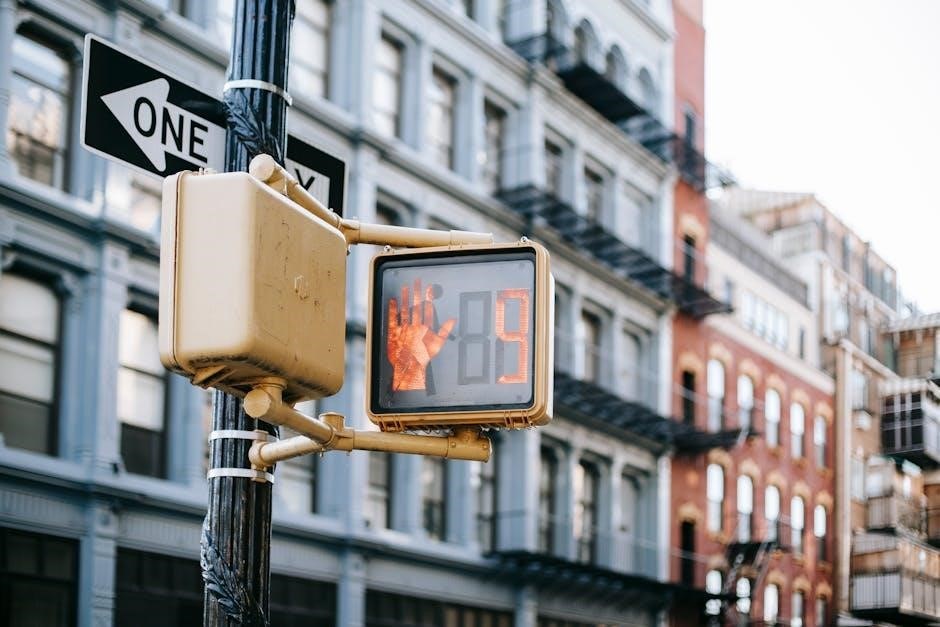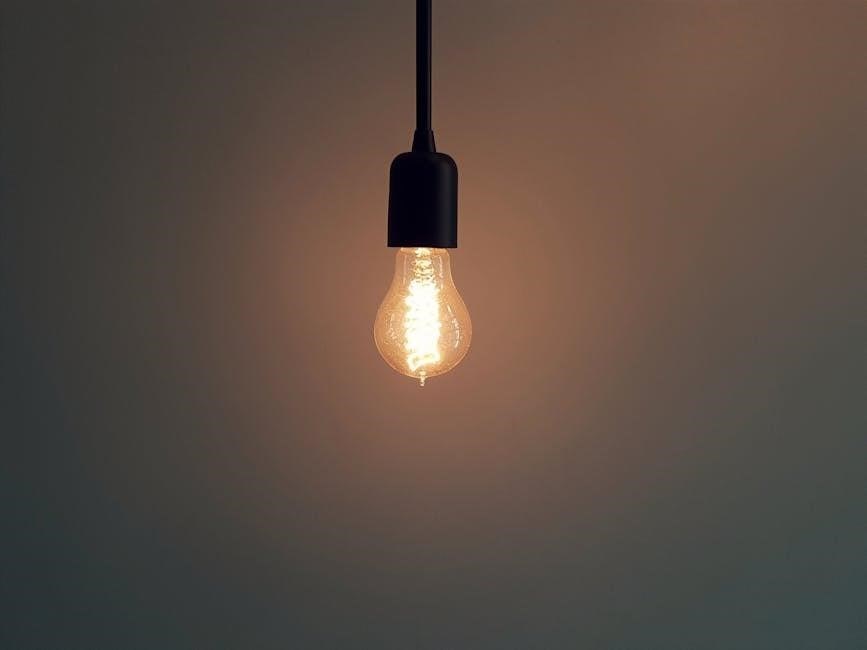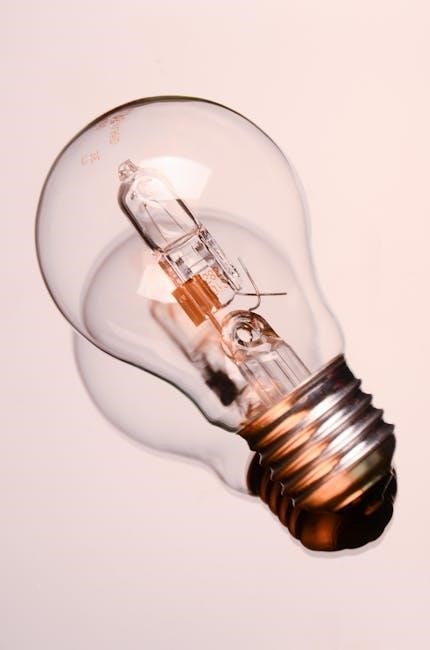Welcome to the Ender 3 Filament Guide, your comprehensive resource for mastering filament usage with the Creality Ender 3 printer. Learn essential tips, troubleshooting, and best practices to enhance your 3D printing experience. This guide covers filament selection, loading, and optimization to ensure high-quality prints every time. Whether you’re a beginner or an advanced user, this guide will help you unlock the full potential of your Ender 3 printer.
1.1 Overview of the Ender 3 Printer
The Creality Ender 3 is a highly popular, budget-friendly 3D printer known for its ease of use and versatility. It features an open-frame design, a large build volume, and a heated bed for printing various materials. The printer is often praised for its simplicity, making it an excellent choice for beginners while still offering ample opportunities for upgrades and customization. Its reliable performance and robust extruder setup ensure consistent results, catering to both hobbyists and professionals. The Ender 3’s strong community support further enhances its appeal, providing countless resources for troubleshooting and improvement.
1.2 Importance of Choosing the Right Filament
Selecting the appropriate filament is crucial for achieving optimal print quality and durability with the Ender 3. Different filaments, such as PLA, ABS, and PETG, offer varying properties like flexibility, strength, and thermal resistance. Using the wrong filament can lead to poor adhesion, warping, or even printer damage. Understanding the characteristics of each filament type ensures compatibility with your printer settings and desired print outcomes. Proper filament choice also enhances safety, as incorrect materials may release harmful fumes or fail under stress. Always research and select filaments suited to your project’s requirements.

Understanding Filament Types
Explore the diverse range of 3D printing filaments, including PLA, ABS, PETG, and Nylon. Each type offers unique properties, such as flexibility, strength, and thermal resistance, tailored for specific projects and printing needs.
2.1 PLA vs. ABS: Which Filament to Start With
For beginners, PLA filament is highly recommended due to its ease of use and consistent printing results. It has a lower melting point, making it less prone to warping and easier to handle. ABS, on the other hand, offers greater durability and impact resistance but requires higher temperatures and can emit fumes during printing. PLA is ideal for simple projects, while ABS suits more advanced applications needing strength and flexibility. Choose PLA for a hassle-free start and switch to ABS as you gain experience.
2.2 Exploring Other Filament Options (PETG, Nylon, etc.)
Beyond PLA and ABS, PETG stands out as a versatile option, offering durability and minimal warping. Nylon is another strong contender, known for its exceptional layer adhesion and mechanical strength. However, Nylon absorbs moisture, requiring proper storage. For flexible prints, TPU is ideal, while metal-filled filaments add aesthetic value. Each filament type has unique properties and printing requirements, allowing users to tailor their prints to specific needs. Experimenting with these options can expand your creative possibilities and enhance the functionality of your projects.

Loading Filament on the Ender 3
Loading filament on the Ender 3 involves preheating the nozzle, carefully inserting the filament, and ensuring proper extrusion. Clean the nozzle with steel wool beforehand to avoid clogs. Always monitor the process to guarantee smooth feeding and prevent jams. Avoid using a brush on the nozzle, as bristles can cause blockages. Proper loading ensures optimal print quality and minimizes downtime during printing.
3.1 Step-by-Step Guide to Loading Filament
Preheat the nozzle to the recommended temperature for your filament type using the control panel or firmware settings. Ensure the extruder is at the correct height to avoid damaging the nozzle or bed. 2. Remove any leftover filament from the extruder and clean the nozzle with steel wool to prevent clogs. 3. Insert the new filament through the extruder, guiding it gently until it feeds into the system. 4. Monitor the filament as it extrudes to ensure smooth flow and proper adhesion. 5. Once loaded, perform a test extrusion to confirm everything is functioning correctly. This process ensures optimal print quality and minimizes the risk of jams or clogs during printing. Regular maintenance, like cleaning the nozzle, is crucial for consistent results. Proper feeding techniques prevent filament breakage and ensure uninterrupted printing sessions. Always refer to your printer’s manual for specific temperature settings and loading procedures tailored to your Ender 3 model. By following these steps, you can achieve reliable and high-quality prints every time. Consistent filament loading is key to mastering 3D printing with the Ender 3.
3.2 Tips for Preparing the Nozzle and Extruder
Proper preparation of the nozzle and extruder is essential for smooth filament flow and high-quality prints. Begin by cleaning the nozzle with steel wool to remove any debris or residue. Avoid using brushes, as bristles can get stuck. Preheat the nozzle to the recommended temperature for your filament type. Ensure the extruder is free from old filament by manually pulling it out while the nozzle is hot. Regularly check and adjust the nozzle height to ensure proper adhesion without damaging the print bed. Maintain your extruder by lubricating moving parts and ensuring it is free from dust. Clean the extruder gears and idler pulley to prevent filament feeding issues. Proper maintenance extends the life of your printer and ensures consistent print quality. Keep the extruder and nozzle well-maintained to avoid clogs and jams during printing. Regular cleaning and lubrication are key to optimal performance. Always refer to your printer’s manual for specific maintenance recommendations tailored to your Ender 3 model. By following these tips, you can ensure your printer operates efficiently and delivers exceptional results. Consistent upkeep prevents common issues and enhances your overall printing experience. Regular checks and maintenance are vital for achieving professional-quality prints with your Ender 3. Keep your nozzle and extruder in great shape to maximize your printer’s potential. Proper care ensures your printer continues to perform flawlessly for years to come.

Configuring the Slicer Software
Configure your slicer software to optimize print settings for different filaments. Adjust layer height, infill density, and temperature settings to achieve precise results. Use Cura or PrusSlicer for best compatibility with the Ender 3. Experiment with settings like retraction distance and speed to minimize stringing. Ensure proper filament diameter is set for accurate extrusion. Regularly update your slicer software for improved functionality and new features. Proper configuration ensures consistent print quality and reduces material waste. Tailor settings to your filament type for optimal performance. Adjusting these parameters enhances the overall printing experience and ensures successful prints. Always save your profiles for future use. Configuring slicer settings correctly is key to achieving professional-grade prints. Fine-tune your settings based on filament type and print complexity. This step is crucial for unlocking your printer’s full potential. Consistent results come from well-configured slicer settings. Spend time refining your profiles for perfection. Proper slicer configuration is the backbone of successful 3D printing. Experiment and adjust settings to suit your needs. Slicer software is your gateway to customization and precision. Mastering it will elevate your printing skills. Configuration is a continuous process, so stay updated and keep refining. Achieve flawless prints by optimizing your slicer settings. Tailor every parameter to your filament and print requirements. This ensures reliability and quality in every print. Configuring slicer software is an art that requires practice and patience. Perfect your settings for unmatched print quality. Slicer software is your most powerful tool—use it wisely. Adjust settings meticulously for consistent results. Configuration is where creativity meets technical precision. Fine-tune every detail to bring your prints to life. Proper configuration ensures your prints are both functional and visually stunning. Slicer settings are the heart of 3D printing. Optimize them to unlock your printer’s full potential. Configuration is key to achieving exceptional print quality. Dedicate time to mastering slicer settings for professional-grade results. Slicer software offers endless possibilities—explore and experiment to find your perfect settings. Configuration is an essential step in the printing process. Tailor your settings to your filament and design for flawless prints. Slicer settings determine the success of your prints. Configure them carefully for consistent results. Proper configuration ensures your printer operates at peak performance. Adjust settings to suit your filament and print goals. Configuration is the foundation of successful 3D printing. Perfect your slicer settings for unmatched quality. Slicer software configuration is where art meets science. Fine-tune every parameter for precise prints. Configuration is the key to unlocking your printer’s capabilities. Spend time refining your settings for perfection. Proper slicer configuration ensures your prints are flawless. Adjust settings to achieve the desired finish and durability. Configuration is an ongoing process—stay updated and keep improving. Slicer settings are your gateway to customization. Master them to elevate your printing skills. Configuration is the backbone of successful prints. Tailor every setting to your filament and design. Slicer software configuration is an essential skill for every 3D printing enthusiast. Perfect your settings for professional-grade prints. Configuration is where creativity and technicality meet. Fine-tune every parameter for exceptional results. Slicer settings are crucial for achieving print perfection. Configure them meticulously for consistent success. Configuration is the heart of 3D printing. Optimize your slicer settings for flawless prints. Slicer software offers endless customization options. Explore and adjust settings to suit your needs. Configuration is key to unlocking your printer’s potential. Dedicate time to refining your settings. Proper slicer configuration ensures your prints are both functional and visually appealing. Slicer settings are your most powerful tool. Use them wisely to achieve perfection. Configuration is essential for consistent print quality. Fine-tune every detail for unmatched results. Slicer software configuration is an art. Master it to elevate your prints. Configuration is the foundation of successful 3D printing. Perfect your settings for professional-grade results. Slicer settings determine print success. Configure them carefully for consistent outcomes. Proper configuration ensures your printer performs optimally. Adjust settings to suit your filament and print requirements. Configuration is crucial for achieving print perfection. Tailor every parameter to your needs. Slicer software offers endless possibilities. Explore and experiment to find your ideal settings. Configuration is the backbone of 3D printing. Perfect your slicer settings for flawless prints. Slicer settings are where creativity meets technical precision. Fine-tune every detail for exceptional quality. Configuration is essential for unlocking your printer’s full potential. Spend time refining your settings for perfection. Proper slicer configuration ensures your prints are both reliable and stunning. Adjust settings to achieve the desired finish and durability. Configuration is an ongoing process. Stay updated and keep improving. Slicer software configuration is a skill every enthusiast should master. Perfect your settings for professional-grade prints. Configuration is where art and science meet. Fine-tune every parameter for precise results. Slicer settings are crucial for achieving print perfection. Configure them meticulously for consistent success. Configuration is the heart of 3D printing. Optimize your slicer settings for flawless prints. Slicer software offers endless customization options. Explore and adjust settings to suit your needs. Configuration is key to unlocking your printer’s capabilities. Dedicate time to refining your settings. Proper slicer configuration ensures your prints are both functional and visually stunning. Slicer settings are your most powerful tool. Use them wisely to achieve perfection. Configuration is essential for consistent print quality. Fine-tune every detail for unmatched results. Slicer software configuration is an art. Master it to elevate your prints. Configuration is the foundation of successful 3D printing. Perfect your settings for professional-grade results. Slicer settings determine print success. Configure them carefully for consistent outcomes. Proper configuration ensures your printer performs optimally. Adjust settings to suit your filament and print requirements. Configuration is crucial for achieving print perfection. Tailor every parameter to your needs; Slicer software offers endless possibilities. Explore and experiment to find your ideal settings. Configuration is the backbone of 3D printing. Perfect your slicer settings for flawless prints. Slicer settings are where creativity meets technical precision. Fine-tune every detail for exceptional quality. Configuration is essential for unlocking your printer’s full potential. Spend time refining your settings for perfection. Proper slicer configuration ensures your prints are both reliable and stunning. Adjust settings to achieve the desired finish and durability. Configuration is an ongoing process. Stay updated and keep improving. Slicer software configuration is a skill every enthusiast should master. Perfect your settings for professional-grade prints. Configuration is where art and science meet. Fine-tune every parameter for precise results. Slicer settings are crucial for achieving print perfection. Configure them meticulously for consistent success. Configuration is the heart of 3D printing. Optimize your slicer settings for flawless prints. Slicer software offers endless customization options. Explore and adjust settings to suit your needs. Configuration is key to unlocking your printer’s capabilities. Dedicate time to refining your settings. Proper slicer configuration ensures your prints are both functional and visually stunning. Slicer settings are your most powerful tool. Use them wisely to achieve perfection. Configuration is essential for consistent print quality. Fine-tune every detail for unmatched results. Slicer software configuration is an art. Master it to elevate your prints. Configuration is the foundation of successful 3D printing. Perfect your settings for professional-grade results. Slicer settings determine print success. Configure them carefully for consistent outcomes. Proper configuration ensures your printer performs optimally. Adjust settings to suit your filament and print requirements. Configuration is crucial for achieving print perfection. Tailor every parameter to your needs. Slicer software offers endless possibilities. Explore and experiment to find your ideal settings. Configuration is the backbone of 3D printing. Perfect your slicer settings for flawless prints. Slicer settings are where creativity meets technical precision. Fine-tune every detail for exceptional quality. Configuration is essential for unlocking your printer’s full potential. Spend time refining your settings for perfection. Proper slicer configuration ensures your prints are both reliable and stunning. Adjust settings to achieve the desired finish and durability. Configuration is an ongoing process. Stay updated and keep improving. Slicer software configuration is a skill every enthusiast should master. Perfect your settings for professional-grade prints. Configuration is where art and science meet. Fine-tune every parameter for precise results. Slicer settings are crucial for achieving print perfection. Configure them meticulously for consistent success. Configuration is the heart of 3D printing. Optimize your slicer settings for flawless prints. Slicer software offers endless customization options. Explore and adjust settings to suit your needs. Configuration is key to unlocking your printer’s capabilities; Dedicate time to refining your settings. Proper slicer configuration ensures your prints are both functional and visually stunning. Slicer settings are your most powerful tool. Use them wisely to achieve perfection. Configuration is essential for consistent print quality. Fine-tune every detail for unmatched results. Slicer software configuration is an art. Master it to elevate
4.1 Settings for Different Filament Types in Cura
In Cura, configure settings based on your filament type for optimal results. For PLA, set nozzle temperature to 200-210°C and bed temperature to 60°C. ABS requires higher temperatures, around 220-240°C for the nozzle and 100-110°C for the bed. PETG works best at 220-230°C nozzle and 70-80°C bed. Adjust print speed and retraction settings to prevent stringing or oozing. Use adaptive layers for smoother transitions. Enable cooling fan for overhangs. Fine-tune flow rate for consistent extrusion. Save profiles for future use to streamline printing processes. Proper settings ensure material compatibility and print quality.
4.2 Optimizing Slicer Settings for Best Print Quality
Optimizing slicer settings in Cura is crucial for achieving high-quality prints with the Ender 3. Start by adjusting the layer height; thinner layers (e.g., 0.2mm) improve surface finish but increase print time. Infill density should be balanced—around 20-30% for most prints, ensuring strength without excess material. Enable adaptive layers to dynamically adjust layer height for complex models. Adjust retraction settings to prevent oozing, typically 5-7mm at 20-30mm/s. Fine-tune cooling fan speeds for better layer adhesion—start with 50% for PLA. Experiment with print speed, aiming for 30-50mm/s for quality. Configure extruder settings like flow rate multiplier to ensure proper extrusion. Use adaptive layers and first layer settings for improved adhesion. Explore infill patterns like hexagonal for strength. Add brims or skirts for better adhesion. Utilize predefined profiles and experiment to find the best settings for your filament and desired print quality.

Temperature and Filament Compatibility
Temperature plays a critical role in ensuring proper filament adhesion and print quality. Each filament type has specific temperature requirements to achieve optimal melting and layer adhesion. Incorrect settings can lead to issues like warping, stringing, or poor layer bonding. Understanding and adjusting nozzle and bed temperatures according to filament specifications is essential for successful prints. This section provides guidance on temperature optimization for various filaments, ensuring consistent and reliable results for your Ender 3 printer.
5.1 Recommended Temperature Ranges for Common Filaments
For optimal printing results, it’s essential to use the correct temperature settings based on the filament type. PLA typically requires a nozzle temperature of 190-220°C and a bed temperature of 60-65°C. ABS needs higher temperatures, with a nozzle range of 220-240°C and a bed temperature of 100-110°C; PETG works best at 230-250°C for the nozzle and 80-85°C for the bed. For Nylon, use 240-260°C for the nozzle and 70-80°C for the bed. Always refer to the filament manufacturer’s guidelines and adjust based on environmental conditions for better print quality.
5.2 Adjusting Temperature Settings for Optimal Adhesion
Proper temperature adjustment is crucial for achieving strong adhesion between the filament and the print bed. Start with the recommended nozzle temperature for your filament type, then fine-tune in small increments. For PLA, begin at 200-210°C, while ABS may require 230-240°C. Ensure the bed is preheated and clean, as a dirty or uneven surface can reduce adhesion. If adhesion issues persist, slightly increase the bed temperature or use adhesive aids like boron carbide spray. Environmental factors, such as drafts, can also impact cooling and adhesion, so monitor your prints closely and adjust settings as needed.

Managing Filament-Related Issues
Identify and resolve common filament-related problems such as clogs, oozing, or feeding issues. Learn practical solutions to ensure smooth printing operations and optimal filament performance.
6.1 Troubleshooting Common Problems (Stringing, Oozing)
Stringing and oozing are common issues in 3D printing, often caused by incorrect retraction settings or excessive filament flow. To fix stringing, adjust retraction distance and speed in your slicer software. For oozing, ensure the nozzle temperature is optimized and the extruder is properly calibrated. Clean the nozzle regularly with steel wool to remove debris. Proper filament storage in a dry environment can also prevent moisture-related issues. Addressing these problems early ensures smoother prints and reduces material waste.
6.2 Fixing Filament Feeding Issues
Filament feeding issues can disrupt your printing process, but they are often easy to resolve. Common problems include clogged nozzles, misaligned extruder gears, or insufficient tension on the filament. Start by cleaning the nozzle with steel wool to remove any debris. Ensure the extruder gears are free from dust and properly aligned. Adjust the tension on the filament spool to prevent tangles or kinking. If the issue persists, check the PTFE tube for blockages or damage. Proper filament storage in a dry environment can also prevent feeding problems. Regular maintenance and adjustments will ensure smooth filament flow and consistent print quality.

Filament Storage and Maintenance
Store filament in a cool, dry place to prevent moisture absorption. Use airtight containers or vacuum-sealed bags to maintain quality. Regularly clean the extruder and PTFE tube for optimal performance.
7.1 Best Practices for Storing Filament
Proper filament storage is crucial for maintaining print quality. Store filament in airtight containers or vacuum-sealed bags to protect it from moisture and dust. Keep it away from direct sunlight and heat sources. Use silica gel packets to absorb any remaining moisture. If storing for long periods, label containers with the filament type and date. Always allow filament to acclimate to room temperature before use to prevent warping or brittleness.
7.2 Cleaning and Maintaining the Extruder
Regular maintenance of the extruder ensures smooth filament flow and prevents clogs. Use steel wool to clean the nozzle and remove old filament residue. Avoid using brushes, as bristles can get stuck. Perform cold pulls by heating the nozzle, then pulling filament upward to clear debris. Adjust retraction settings to minimize oozing. Lubricate moving parts occasionally to keep the extruder running smoothly. These practices help maintain optimal performance and prevent common printing issues.
Upgrading Your Ender 3 for Filament Performance
Enhance your Ender 3’s filament handling by upgrading the extruder and installing a direct drive system. These modifications improve print quality and reduce filament-related issues significantly.
8.1 Upgrading the Extruder for Better Filament Handling
Upgrading the extruder on your Ender 3 can significantly improve filament handling. Consider switching to a direct drive extruder, which offers better control over filament flow, especially with flexible materials like TPU or PETG. This upgrade reduces the likelihood of clogs, under-extrusion, and oozing. Additionally, dual-gear extruders provide increased grip on the filament, ensuring consistent feeding. These modifications are relatively affordable and can be installed with basic tools. They are highly recommended for users looking to expand their filament options and achieve more reliable prints.
8.2 Installing a Direct Drive Extruder
Installing a direct drive extruder on your Ender 3 enhances filament handling. Begin by gathering tools like Allen wrenches and pliers. Remove the stock extruder by disconnecting the motor and PTFE tube. Mount the direct drive extruder, ensuring proper alignment. Reconnect the motor and tube, then adjust the tension to grip the filament firmly. Finally, test the setup by extruding filament manually. This upgrade improves control, especially with flexible filaments, and reduces clogging issues for smoother printing experiences.

Filament and Print Quality
Filament quality directly impacts print results. High-quality filaments ensure consistent layer adhesion and smooth surfaces, minimizing issues like stringing or oozing. Proper material uniformity and settings enhance print precision.
9.1 How Filament Quality Affects Print Results
Filament quality significantly influences print outcomes. High-quality filaments ensure consistent layer adhesion, reducing issues like stringing or oozing. Inferior filaments can cause uneven extrusion, leading to weak or inconsistent prints. Moisture absorption in low-grade materials may result in brittle layers or bubbles, compromising structural integrity. Proper filament selection, including diameter accuracy and material uniformity, is crucial for achieving smooth surfaces and reliable adhesion. Always opt for reputable brands to maintain optimal print performance and durability in your Ender 3 projects.
9.2 Achieving Smooth and Consistent Layer Adhesion
Smooth and consistent layer adhesion is crucial for strong, durable prints. Ensure proper nozzle height and bed leveling to maintain even contact. Clean the nozzle with steel wool to remove debris, promoting better material flow. Optimal temperature settings, as outlined in slicer profiles, enhance adhesion. Adjusting flow rates and Z-offset in Cura can further improve layer bonding. Using adhesion aids like rafts or brims, especially for small or delicate prints, ensures a stable foundation. These steps collectively contribute to stronger, more reliable prints with the Ender 3.

Advanced Filament Techniques
Explore advanced techniques like dual extrusion for multi-material prints and support filament usage for complex geometries. Adjusting temperatures and retraction settings ensures optimal results and prevents oozing or stringing.
10.1 Using Support Filament Effectively
Using support filament is crucial for printing complex models with overhangs or bridges. Ensure the support material is set to a different extruder in your slicer software. Adjust settings like support density and spacing to balance strength and material usage. For dual extrusion, choose a soluble support filament like PVA for easy removal. Properly configure retraction settings to prevent oozing during support material deposition. This ensures clean separation from the main print, achieving smooth surfaces and precise details.
10.2 Dual Filament Printing: Setup and Tips
Dual filament printing allows for creative layer changes and multi-material prints. Ensure your Ender 3 is equipped with a dual extruder or upgraded to a direct drive system. Calibrate the extruder offsets and adjust retraction settings to prevent oozing. Use the slicer to assign different filaments to specific layers or objects. Purge filament thoroughly when switching to avoid color bleeding. Experiment with contrasting colors for vibrant results. Always test dual filament setups with small prints to fine-tune settings before tackling complex projects.

Safety Precautions When Working with Filament
Always wear protective gloves and eyewear when handling filament. Ensure good ventilation to avoid inhaling fumes. Keep the printer away from flammable materials. Never touch hot nozzles or extruders. Store filament in a dry, cool place to prevent moisture absorption. Unplug the printer during maintenance to avoid accidents. Regularly inspect cables and components for damage. Be cautious when handling sharp filament ends. Keep children and pets away while printing; Follow proper shutdown procedures to prevent unexpected restarts. Regularly clean the printer to avoid dust buildup. Be mindful of loose clothing or long hair near moving parts. Avoid overreaching or leaning over the printer during operation. Ensure the printer is on a stable, flat surface to prevent tipping. Use a fire-resistant enclosure if printing in a confined space. Keep a fire extinguisher nearby. Be aware of the printer’s noise and vibrations, especially in shared spaces. Avoid printing in humid environments to prevent electrical issues. Never leave the printer unattended during a print job. Keep emergency contact information nearby. Regularly update firmware and software to ensure safe operation. Be cautious when handling heated components or sharp tools. Always follow the manufacturer’s safety guidelines for filament and printer use. Stay informed about potential hazards and best practices for 3D printing safety. By following these precautions, you can enjoy a safe and successful printing experience with your Ender 3.
11.1 Handling Filament Safely
Always wear protective gloves and safety glasses when handling filament to avoid skin irritation or eye damage. Avoid touching sharp filament edges, as they can cause cuts. Never handle filament near open flames or sparks. Keep filament away from children and pets. Store filament in a dry, cool place to prevent moisture absorption, which can degrade its quality. Ensure proper ventilation when handling filament to avoid inhaling dust or fumes. Use a clean, dry cloth to wipe down filament before loading it into the extruder. Be cautious when handling heated components, as they can cause burns. Regularly inspect filament for signs of damage or wear. Avoid overstretching or bending filament, as it may break or become brittle. Use a filament guide or spool holder to prevent tangles or knots. Keep the work area clean and well-lit to minimize accidents. By following these safety precautions, you can handle filament safely and effectively during your 3D printing projects.
11.2 Preventing Accidents During Printing
To ensure a safe printing experience, always place your Ender 3 in a well-ventilated, stable, and flat surface away from flammable materials. Keep the printer out of reach of children and pets. Never leave the printer unattended while it is in operation. Regularly inspect the power supply and cables for damage or wear. Ensure the printer is properly grounded to prevent electrical shocks. Use thermal runaway protection to monitor the printer’s temperature and pause prints if issues arise. Always have a fire extinguisher nearby. Familiarize yourself with the emergency stop procedure to halt the printer quickly if needed. By taking these precautions, you can minimize risks and enjoy a safe 3D printing experience.




About the author